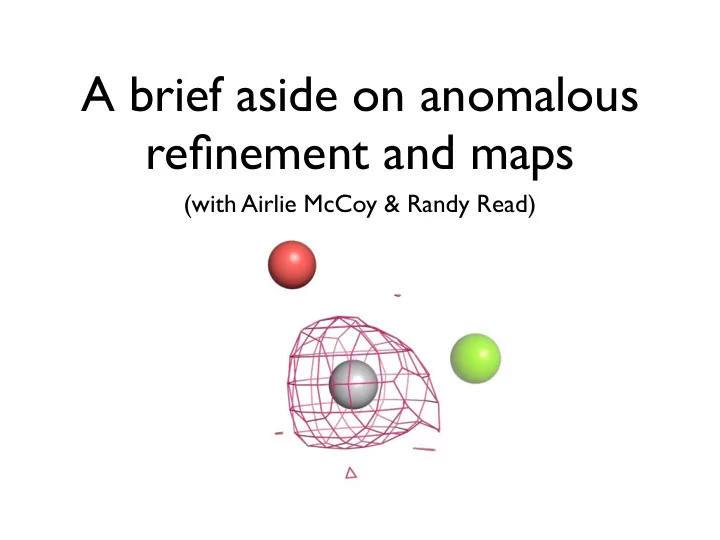

A brief aside on anomalous refinement and maps (with Airlie McCoy & Randy Read)
Computing SAD LLG maps from Phenix • Added map_type=llg (or “llgsad”) in October 2012 • Using existing partially working SAD target code, with modifications • Inputs are a PDB hierarchy and fmodel object • Use fmodel to supply F(calc), instead of generating it fresh from the PDB hierarchy • This will work best if anomalous groups are refined and contribute to F(calc) • but we can also guess f’/f’’ if wavelength is specified • Appearance for a purely real model is similar to anomalous difference map, at least for actual anomalous groups • Testing by calculating maps from phenix.refine after anomalous group refinement of selected heavy atoms
LLG versus anomalous difference • Output from phenix.refine run of 3s6f, with f’ and f’’ refined for Se atoms only yellow = anomalous @ 3 sigma; orange = LLG @ 3 sigma
LLG versus anomalous difference • Peak on calcium ion goes from < 5 sigma to > 10 sigma yellow = anomalous @ 3 sigma; orange = LLG @ 3 sigma
LLG versus anomalous difference • With anomalous scattering refined for both SE and CA, the P and S atoms in 3s6f become clear in the LLG map
Advantages and limitations of LLG maps • The main disadvantage of implementing the substructure completion in Python is that it’s 2x slower than Phaser • Even just calculating an LLG map by itself has a large overhead; can we get away with something simpler? • using an unweighted anomalous difference-difference map, 26 anomalously scattering “waters” can be picked in Ubq structure containing CdCl 2 • with LLG map, 30 anomalous scatterers found • timings: ~25s versus ~340s (inc. anomalous refinement) • so Phaser’s maps really are more sensitive, but at least an order of magnitude slower
Incorporating anomalous refinement • Theoretically all elements have anomalous scattering, but at MX wavelengths only P and higher will be detectable • We could automatically flag any suspicious water for anomalous refinement (as well as any new ions) • Use anomalous residual map (or LLG map) to identify • refined f’ and f’’ give us orthogonal information about identity (since f’ will estimate the occupancy error in e- ) • In effect we get a crude mimic of the substructure completion in Phaser, but with chemical knowledge added • This does in fact work - but with mixed results so far compared to Phaser
Recommend
More recommend